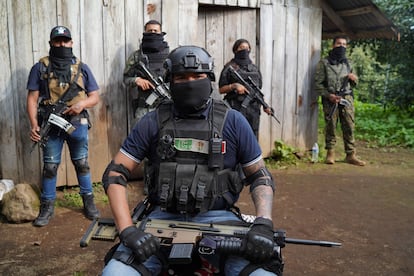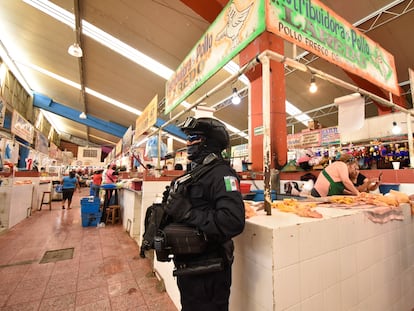Study reveals organized crime is the fifth-largest employer in Mexico
An investigation published in ‘Science’ estimates the cartels contain around 175,000 people and recruit some 350 new members every week to cover losses from violence and imprisonment


Organized crime is Mexico’s fifth-largest employer, accounting for between 160,000 and 185,000 people and the only way to crack down on the problem is to prevent the recruitment of new members in a country where criminal groups enlist 350-370 people into their ranks every week. These are the conclusions of a study by the Complexity Science Hub Vienna, published Thursday in the journal Science. It is one of the most ambitious approaches to the difficult task of quantifying in numbers the power that criminal groups hold in Mexico.
The lead researcher on the study, former Mexico City police officer Rafael Prieto-Curiel, says the path is clear: “Neither through the courts nor through the prisons. The only way to reduce violence in Mexico is to cut off cartel recruitment.” The researchers combined data on murders, missing persons, incarcerations, and cartel interactions between 2012 and 2022 to reach this conclusion.
One of the most relevant findings from the study is that despite the imprisonment of thousands of members, the size of criminal organizations is larger than it was 10 years ago. Mexican authorities sentence around 6,000 cartel members to prison terms every year. However, Mexico’s cartels had 60,000 more members in 2022 than they did in 2012. In total there are around 175,000 members of criminal organizations, according to the study, which would make the cartels Mexico’s fifth-largest employer, ahead of companies such as state owned petroleum company Pemex and convenience store chain Oxxo and only surpassed by FEMSA (a beverage and retail company and the world’s largest independent Coca-Cola bottling group), Walmart, Manpower, and America Movil.
The results also provide data on how many members each criminal group contains: almost two out of every 10 belong to the Jalisco New Generation Cartel while the Sinaloa Cartel accounts for one out of every 10. This data only takes into account people directly linked to cartel violence and not other people connected to the drug-trafficking trade, such as the financial managers in charge of laundering the money.
The cartels lose many members to violence. Data obtained by the researchers show that over the 10-year period studied, 17% of cartel recruits died and a further 20% were imprisoned. As such, the report states that due to the rate of loss experienced by organized crime groups between arrests and murders, the cartels need to recruit 350-370 people every week to avoid collapse. But many of those who join do not do so voluntarily: forced recruitment is the most-used system among the cartels, and one of the most painful for the families of the disappeared.
If cartel recruitment was cut in half, by 2027 they would be 11% smaller overall. “Mathematically, therefore, a preventive strategy is much more successful than a traditional reactive strategy,” the report notes. Conversely, if the cartels continue at their current levels of recruitment and violence, by 2027 there could be 26% increase in the number of cartel members and 40% more casualties.
The study defines itself as the first to estimate in figures “the black box” that drug trafficking represents, as it is extremely difficult to quantify its power and identify its mechanisms due to its economic, social and political importance, and its opacity throughout the Mexican territory. The director of crime research company SciVortex, Eduardo Salcedo Albarán, says the mathematical model obtained by the study is “amazing,” and that it is a good starting point to achieve better systems to investigate cartels in the future. He also encourages governments at all levels in Mexico to try different strategies to combat drug trafficking. “The hardest part is bringing these ideas to the real world,” he said.
Sign up for our weekly newsletter to get more English-language news coverage from EL PAÍS USA Edition
Tu suscripción se está usando en otro dispositivo
¿Quieres añadir otro usuario a tu suscripción?
Si continúas leyendo en este dispositivo, no se podrá leer en el otro.
FlechaTu suscripción se está usando en otro dispositivo y solo puedes acceder a EL PAÍS desde un dispositivo a la vez.
Si quieres compartir tu cuenta, cambia tu suscripción a la modalidad Premium, así podrás añadir otro usuario. Cada uno accederá con su propia cuenta de email, lo que os permitirá personalizar vuestra experiencia en EL PAÍS.
¿Tienes una suscripción de empresa? Accede aquí para contratar más cuentas.
En el caso de no saber quién está usando tu cuenta, te recomendamos cambiar tu contraseña aquí.
Si decides continuar compartiendo tu cuenta, este mensaje se mostrará en tu dispositivo y en el de la otra persona que está usando tu cuenta de forma indefinida, afectando a tu experiencia de lectura. Puedes consultar aquí los términos y condiciones de la suscripción digital.
More information
Archived In
Últimas noticias
Most viewed
- Alain Aspect, Nobel laureate in physics: ‘Einstein was so smart that he would have had to recognize quantum entanglement’
- Mexico’s missing people crisis casts a shadow over World Cup venue
- Why oil has been at the center of Venezuela-US conflicts for decades
- Trump clarifies who is ultimately in charge in Venezuela: ‘Me’
- Mexico seeks to shore up its defenses following US incursion in Venezuela










































